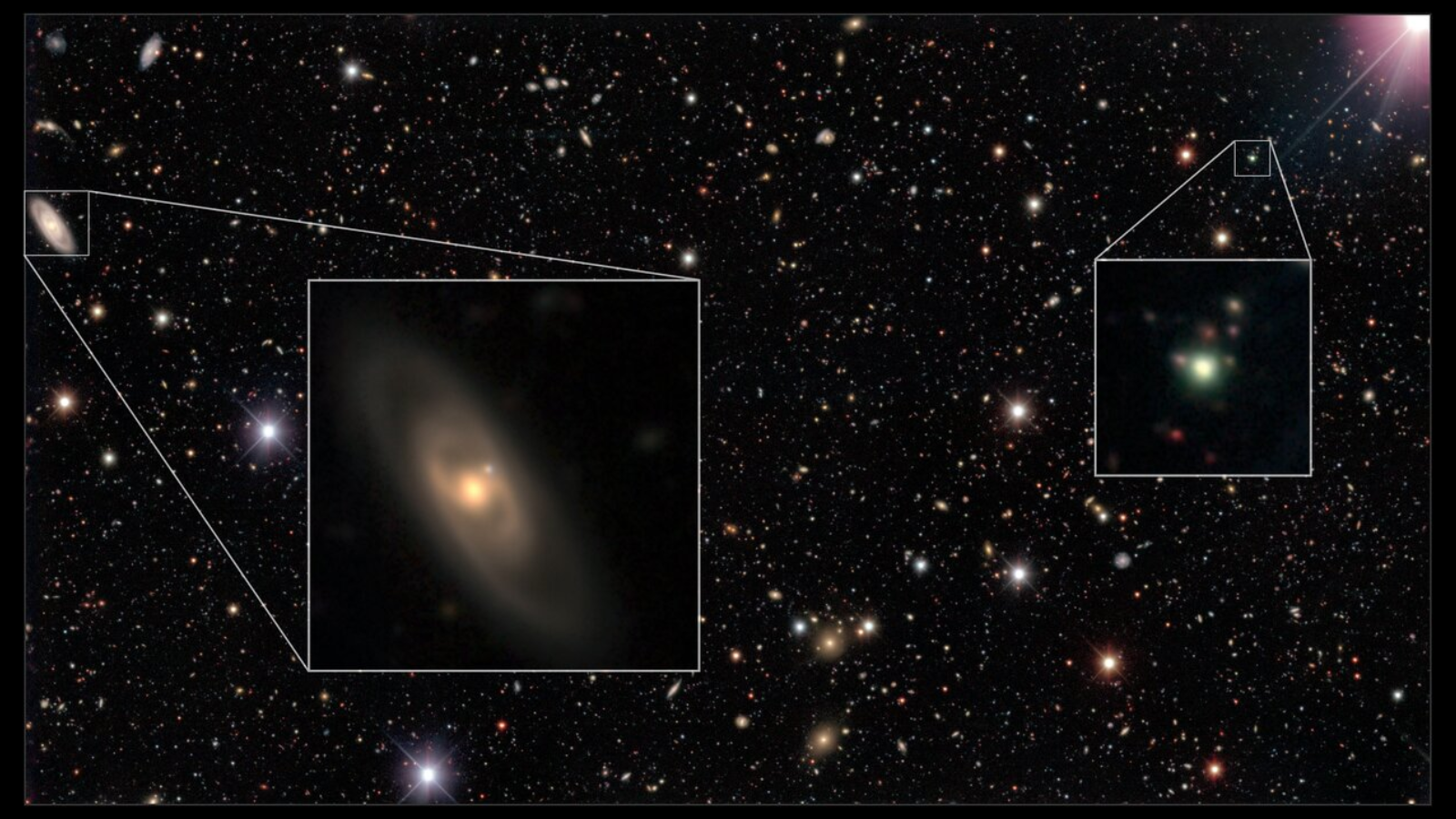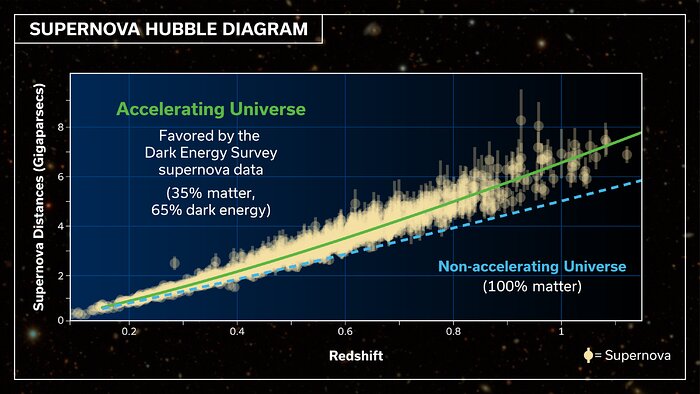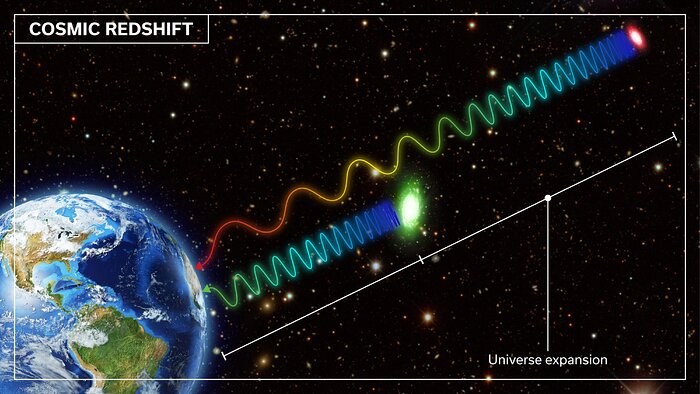Decade-long Dark Energy Survey offers new insights into the expansion of the universe
The most recent results from a survey of over 1,500 supernovas calls the standard model of cosmology into question.

A survey of over 1,500 supernovas conducted by the Dark Energy Camera has placed strong constraints on the accelerating expansion of the universe.
The results suggest that the mysterious force that drives this cosmic acceleration, dark energy, may change over time, varying in density, which calls the standard model of cosmology into question.
Related: Dark energy remains a mystery as Einstein's theory of gravity passes another test
The results were delivered by the largest sample of supernovas ever harvested by a single instrument as part of the Dark Energy Survey. Supernovas were integral to the discovery in the late 1990s that not only is the universe expanding, but it is also doing so at an accelerating rate.
That was a huge surprise to physicists, who had expected that after the initial rapid inflation of the cosmos during the Big Bang. Cosmic expansion should have slowed down, but it is speeding up.
Dark energy was suggested as a placeholder for whatever unknown aspect of the universe is causing that mysterious and troubling cosmic acceleration, but scientists can't say for certain what it is. That problem is compounded by the fact that dark energy is now thought to account for 65% to 70% of the total energy and matter in the cosmos.
The Dark Energy Survey conducted by the Dark Energy Camera mounted on the Víctor M. Blanco 4-meter Telescope at Cerro Tololo Inter-American Observatory in Northern Chile shows that observations of supernovas remain integral to solving the mystery that such investigations triggered 25 years ago.
Breaking space news, the latest updates on rocket launches, skywatching events and more!
The new Dark Energy Survey results were presented at the 243rd meeting of the American Astronomical Society on Jan. 8, 2024, with the team behind them adding they are consistent with the standard model of cosmology, the so-called "Lambda cold dark matter" model (ΛCDM), that features a universe with accelerating expansion.
These place the tightest constraints on the history of expansion throughout the 13.8 billion-year history of the cosmos, but they also leave breathing room for more complex models of the universe.
Investigating dark energy with standard candles
To gather this data, the 570-megapixel Dark Energy Camera built by Fermilab observed the sky over Earth for 758 nights, observing 2 million distant galaxies. Within these, the powerful camera spotted thousands of supernovas.
Of this sample, machine learning was able to determine that 1,499 were a special type of stellar explosion called a Type Ia supernova. These occur when dead stars called white dwarfs, which have long exhausted hydrogen to drive nuclear fusion and convert to helium in their cores, exist in a binary system with another star.
The white dwarfs drag material from their companion or "donor" star, and as this matter piles up on the dead star, it can push the white dwarf beyond the so-called Chandrasekhar limit. This is the mass limit that a star needs to go supernova.
These Type Ia supernovas are so uniform that scientists refer to them as "standard candles," and their light can be used to measure vast distances across the cosmos.
Additionally, because the wavelength of light from distant objects is stretched toward the red end of the electromagnetic spectrum, a process called "redshift," as they move away from Earth, the uniform light output of standard candles at varying distances can be used to measure the expansion of the universe.
Comparing the redshift of closer Type Ia supernovas to the redshift of more distant, and thus earlier, white dwarf explosions can, therefore, give a hint at the strength of this expansion and thus the density of dark matter at the corresponding periods in cosmic history.
The new Dark Energy Survey results triple the known number of supernovas at a redshift of around 0.2, which corresponds to a distance of about 2.5 billion light-years away. It quintuples the known number of standard candles with a redshift of around 0.5, which correlates to a distance of around 6 billion light-years away.
"It's a really massive scale-up from 25 years ago when only 52 supernovae were used to infer dark energy," Dark Energy Survey working group member and University of Queensland professor Tamara Davis said in a statement.
Dark energy wasn't always so dense
With such a larger sample size of Type Ia supernovas across such a width of cosmic distances, the team could trace out a record of cosmic expansion when combining the distances of these explosions with the speed at which they are receding from Earth.
This acted as an indication of whether dark energy density had remained stable, which seemed not to be the case.
"As the universe expands, the matter density goes down," Dark Energy Survey director and spokesperson Rich Kron said in the same statement. "But if the dark energy density is a constant, that means the total proportion of dark energy must be increasing as the volume increases."
This might be a challenge to the ΛCDM model of the universe, a mathematical model that describes how the universe evolves with just a few key features like the density of matter, the type of matter, and the behavior of dark energy.
That is because ΛCDM assumes the density of dark energy is constant and doesn't dilute as the universe expands, something these supernova survey results suggest may not be true.

"There are tantalizing hints that dark energy changes with time. We find that the simplest model of dark energy — ΛCDM — is not the best fit," Davis added. "It's not so far off that we've ruled it out, but in the quest to understand what is accelerating the expansion of the universe, this is an intriguing new piece of the puzzle. A more complex explanation might be needed."
Answers to this conundrum may have to wait until the next generation of supernova surveys gets started and picks up from the Dark Energy Survey.
"This result clearly shows the value of astronomical survey projects that continue to yield excellent science well after data collection has ended," National Science Foundation Astronomical Sciences Division program director Nigel Sharp said in the same statement.
"We need as many diverse approaches as we can get in order to understand what dark energy is and what it isn’t. This is an important route to that understanding."
The Dark Energy Survey results have been submitted to the Astrophysical Journal.

Robert Lea is a science journalist in the U.K. whose articles have been published in Physics World, New Scientist, Astronomy Magazine, All About Space, Newsweek and ZME Science. He also writes about science communication for Elsevier and the European Journal of Physics. Rob holds a bachelor of science degree in physics and astronomy from the U.K.’s Open University. Follow him on Twitter @sciencef1rst.

